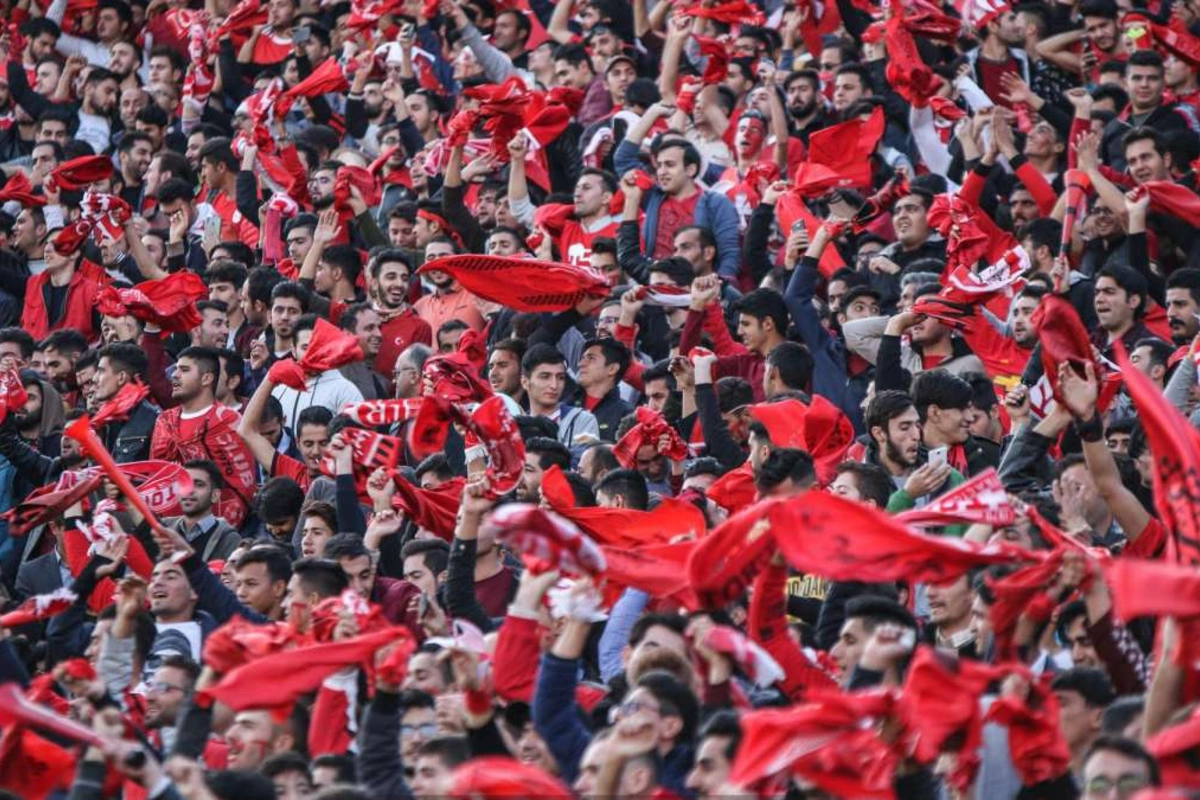
For the large group of Azerbaijani-Turks living in Iran ethno-linguistic expression is complicated. At Tractor FC football matches, however, they can “voice their otherwise silenced opinions and discontents while sharing in a sense of mutual solidarity.” Can a football stadium really contain all that pride?
Tractor Football games draw full stadiums in northern Iran, both home and away. Image: Tractor Football Club Official Website
Thanks to mass media, the mention of Iran brings plenty of different images to mind. Memoirs like Azar Nafisi’s Reading Lolita in Tehran, and the 2012 film Argo, certainly influenced how I envisaged the country when growing up in Canada. However, then I moved to Baku, Azerbaijan, a city less than five hours’ drive north of the Iranian border. Since then, I have begun to see Iran from a whole new perspective.
During the Second Karabakh War last fall, I was sent an unusual YouTube video filmed at a Tractor FC soccer game. The video was fascinating not because of the goalmouth action. Indeed players didn’t feature. The footage, instead, was of fans in Tractor FC jerseys, packed like sardines into a Tehran stadium and singing their hearts out. The song that they belted out was not a football chant but an Azerbaijani song by Uzeyir Mehdizade. It’s one that I had heard many times – in taxis and Baku restaurants – one of those popular songs that get overplayed here. One hand on their heart, one in the air, the

Translated, the lyrics mean something like this:
“I’m proud of my homeland
Long live Azerbaijan!
Our young people with you
Long live Azerbaijan!
If you call me, I will come running
Long live Azerbaijan!
Come what may, I would even die for you
Long live Azerbaijan!”
It’s a scene that you might expect if they were supporting a team from Baku. Yet Tractor FC is from Iran. On reflection, though, perhaps I shouldn’t have been so surprised. After all, Tabriz is the largest city in an area of Iran that’s populated mainly by people of ‘Azerbaijani-Turk’ descent. It’s an area that many in Baku refer to as “South Azerbaijan.” What was going on at that soccer game is part of a very long story.
No matter whose company you are in, in the Republic of Azerbaijan, you’re likely to hear the same trio of reactions when you mention Iran.
“Pistachios are half the price” – cheap prices make Iran a great place to shop.
“Let me give you the WhatsApp number of my nose guy!” – it’s also a hub for medical tourism and plastic surgery.
And lastly, without fail – “There are more Azerbaijanis in Iran than in Azerbaijan, you know.”
Residents of Baku often refer to the six provinces of Northwestern Iran as “South Azerbaijan,” some with a twinkle in their eye, others without a trace of humour.
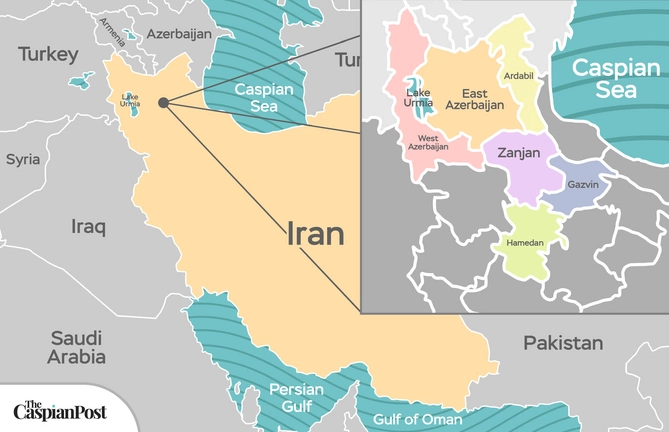
Official demographic statistics in Iran don’t generally include self-declared ethnic identity. For this reason, estimates of Iran’s Azerbaijani Turk population range wildly: from 18 million to 40 million, depending on who you might be talking to. A realistic estimate would be that they constitute well around 23% of the entire population of Iran, concentrated most significantly in the six northwestern provinces. This area, along with what is now the Republic of Azerbaijan, had once been governed as a patchwork of semi-independent Turkic khanates, Muslim mini-kingdoms that had gained autonomy from the Persian Empire in the mid-18th century and were later fought over by Imperial Russia and Qajar Persia. Long story short, the Gulistan (1813) and Turkmenchay (1828) treaties saw land to the south of the Aras River go to Persia (now known as Iran), and those north of the Aras to Russia.
Extended families and long-held connections were severed in these agreements, especially – after several historical twists and turns – once the Russian Empire became the relatively closed USSR. As a result, a shared culture and language would now be influenced differently on either side by outside forces. These days, Azerbaijani Turks in Iran are neither Turkish nor Iranian. But neither are they quite the same as their Azerbaijani brothers to the north. They are, perhaps, a distinct combination of all three, with a unique culture and history.
Few socio-linguistic issues are as passionately cherished as is mother-tongue education. It has been well documented that when a child begins elementary school in a language they are not speaking at home, they miss out on crucial learning fundamentals and will pay the price throughout their education. UNESCO encourages mother tongue education during primary school years before switching to the national language, enabling kids to grasp the most important concepts without the added stress of learning a new language simultaneously. In an article for Pakistan’s Cutting Edge, Rasheed Ali writes, “…it is through the mother tongue that cognitive skills flourish in such a manner that the learner is able to critically evaluate, visually imagine and calculate. Likewise, scientific concepts are better built if taught in the mother tongue.”
So, as someone trained in socio-linguistics, I was keen to discover for myself the status of Azerbaijani speakers’ language rights in Iran. Do families have access to mother tongue education for their children? Bilingual education, perhaps? Is there government funding for programming? Does the government recognize ethnicities at all? Are they permitted to hold meetings, celebrations or ceremonies in their language? Despite the Supreme leader of Iran, Ayatollah Ali Khamenei, himself being Azerbaijani Iranian on his father’s side, the answer to all these questions proved to be a somewhat resounding no. According to the Iranian Education Ministry, even having a “thick accent” makes you unfit to teach.
Does this attitude mean that Azerbaijani-Turks in Iran are in some way oppressed? The question is both complex and controversial. The answer is likely to depend very much upon who you ask. And when.
Take the issue of water shortages. As we saw recently with the Ahwazi’s protests in July 2021 over the redirection of the Karkeh River, mismanagement of natural resources can be the source of deep mistrust between minority peoples and the national government. In the northwest of Iran, Lake Urmia, a UNESCO-listed biosphere reserve whose surface area has shrunk by 90% in the last few decades, has been dubbed the “Azerbaijani-Turks’ Karkeh River.” Many large saline bodies of water worldwide are drying up at an alarming rate, but some Azerbaijani-Turks in Iran blame the government for the speed of this particular disaster and insist that the neglect of the lake is due to the ethnicity that surrounds and uses it.
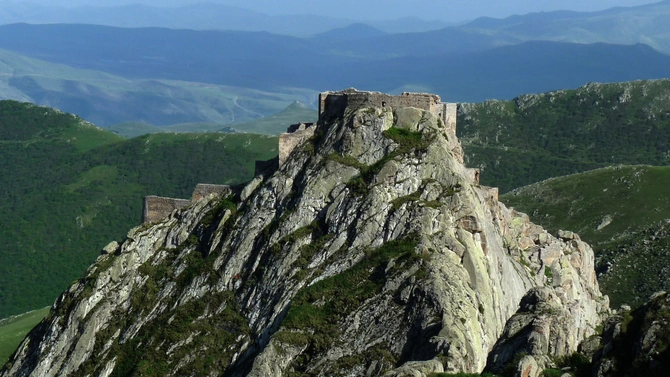
More directly ethnopolitical was the controversy over Babek Castle, one of northern Iran’s most dramatic tourist sights. The imposing cliff-top ruins are integrally associated with 9th-century Azerbaijani hero Babek Khorramdin, who started a 22-year uprising against the Arab Caliphates in 815AD. Since around 1999, thousands of Azerbaijani Turks in northwestern Iran would run the gauntlet of official disapproval and walk the 14km from Kaleybar to Babek Castle as a celebration of the hero’s birthday. However, in 2005, scores of people were reportedly arrested during the walk, and at least 21 were sentenced to prison terms of up to one year. In 2006 the celebration was essentially stopped altogether as tensions between Azerbaijani-Turks and the Iranian authorities came to a head.
The spark was the publication of a provocatively insulting cartoon in the children’s section of a state newspaper. Persian speakers often mock the Azerbaijani language as sounding uneducated. However, this slur went much further, discussing ways to kill and torture “cockroaches”, which – the cartoon’s satirical punch line suggested – could only speak Azerbaijani[1]. Although the cartoonist was imprisoned and the newspaper shut down in response to this tasteless episode, the reaction was a wave of street demonstrations amongst Azerbaijani Iranians. The protests were crushed. Amnesty International reported that thousands were detained, hundreds arrested, and 27 killed. The authorities accepted that there were casualties but disputed numbers.
At the time, this was seen in the West as exemplifying Iran’s intolerance towards minorities. However, before jumping to black-and-white conclusions, it’s worth reminding ourselves of the date: May 2006. It was around that time that George W Bush’s US regime, having invaded Afghanistan and toppled Saddam Hussein’s Iraq, was engaging in increasingly vociferous sabre-rattling towards Iran, which he’d branded part of an “axis of evil.” In April 2006, the question of the US going to war with Iran was being widely discussed by global news media. In that context, it seems a little less surprising that the country was heavy-handed in controlling ethnolinguistic demonstrations that might have been open to manipulation. The Amnesty International report on the ‘cartoon demonstrations’ mentions that authorities had claimed that the disturbances had been stirred up by “US and other outside forces.”
Whatever the cause, the result was that the annual walk to Babek fortress became so highly controlled that it essentially lost its appeal. That most prominent outlet for ‘walking out’ ethnolinguistic identity and celebrating the solidarity of shared history was now out of reach.
A crucial historical aside at this point is to remind ourselves that the very idea of ethnolinguistic national identities in the modern sense is essentially a concept that developed in 19th century Europe. The three empires that then straddled the Caspian Region – Russian, Persian and Ottoman, remained great multi-cultural melting pots until WWI. However, after the utter devastation of the Great War, each took a very different approach to the new world order of nation-states. The Ottoman Empire shattered into a plethora of smaller countries while, at its core, republican Turkey focused – brutally and semi-successfully – on creating a relatively homogenous Turkish identity. The Russian Empire took a different approach, piecing itself back together in the 1920s as a union of nominally separate Soviet republics, each with its own ethnolinguistic identity but officially placing pro-Russian, socialist doctrine above ethnicity. Like Turkey, the Persian Empire – which had already been significantly diminished in the 19th century through losses to neighbours – was absolutely brutalized by WWI. Although neutral on the surface, much of the empire had been carved up between competing powers and between 1917 and 1919 as much as a quarter of the population died.
The ruins of the empire were reborn as the nation-state of Iran. To unify the wrecked country, the new regime of Reza Pahlavi adopted a language policy demanding that all governance, education and publishing be conducted in Persian. The result was that mother-tongue literature and schooling were stamped out for over half of the population, including Kurds, Lurs, Ahwazi Arabs, Baluchis, Turkmens and notably Azerbaijani-Turks. However, the Persian language policy was arguably less ruthless than similar moves in republican Turkey, and these days a plurality of minority languages remain very widely spoken on a day-to-day basis. In this way, more than many other countries, Iran has retained some of the multi-ethnic flavour of the pre-WWI Middle East.
Ironically, despite the contemporary West’s post-modern calls for multiculturalism, Iran’s deeper-rooted, lower-key model of widespread ethnic mixing is often seen as out of step with a 21st-century world dominated by identity politics.
Since the 1930s, Iran has often equated attempts to demand additional non-Persian language rights with moves towards separatism. And indeed, foreign powers periodically have tried to amplify or even create ethnic tensions as a tool to undermine Tehran. The most egregious example was after WWII. Wartime Iran had once again been divided (between British and Russian forces). After the war, Stalin wanted to hang onto a part of his southern conquests. So to solidify the Soviet occupation of northwestern Iran, two puppet states were created - the notionally Kurdish Mahabad Republic and the Azerbaijan People’s Government centred in Tabriz. Both were justified as ostensibly representing peoples whose language rights had been trounced by an essentially imperialist Persia. While language rights were indeed a point of contention, there is little doubt that the banner of ethnic liberation was a fairly transparent smokescreen for territorial expansion of the USSR and that, in reality, the Tabriz ‘government’ was managed mainly by the Soviet regime via Baku. Memories of this short-lived experiment have long since faded in the West. However, the history is clearly remembered in Iran, which now looks with skepticism every time there are calls for greater language rights – worrying that this might be another pretext for foreign intervention.
The Islamic Republic is not a country that’s generally tolerant of opposition demonstrations, and its 2006 crackdowns against the “cartoon protesters” were indeed a dreadful over-reaction. However, a few years later – with Obama in the White House and international tensions slightly easing – a 2010 report for Radio Free Europe suggested that only a small minority of Azerbaijani-Turks were then concerned about the status of their language provision in Iran. Indeed, several worried that if their children were educated primarily in Azerbaijani, this might undercut their chances of future success in a society where speaking Persian is a prerequisite.
Since Trump’s unilateral cancellation of the Iran nuclear deal and imposition of harsh international sanctions, tensions with and within Iran have risen again.
As Dr. Brenda Shaffer has written in her 2020 monograph, Iran is More than Persia, since Iran “does not allow explicit ethnically based political organizations, parties, or activity… non-political arenas, such as sport and environmental activity, serve as surrogates for political fora.”
This brings us back to Tractor FC. The football club was founded in 1970 at an actual tractor plant in Tabriz. Currently playing in Iran's top soccer league, the team has gained international attention in recent years by reaching the group stages of the AFC Champions League in 2013 and being briefly coached in 2018 by 1970s hero of Wales and Liverpool, John Toshack.
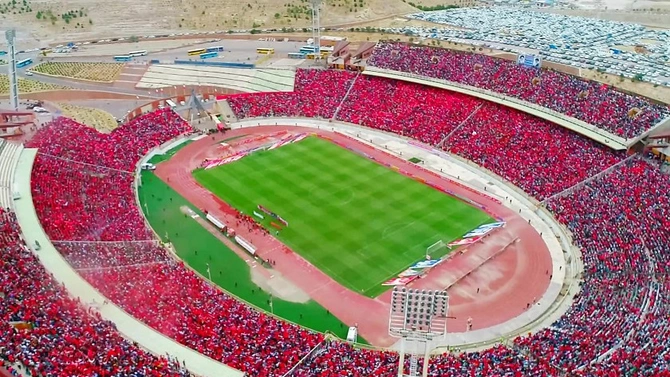
Tractor matches tend to attract a steady attendance of around 60,000 fans. While gathered together, those fans often seem to find courage in such large numbers to voice their otherwise silenced opinions and discontents while sharing in a sense of mutual solidarity.
YouTube videos of fans at the games, like the one described at the start of this article, often appear to be displays of Azerbaijani Turk unity. The slogans are varied and often creative. Overtly political examples include:
“Tabriz, Baku, Ankara, our path leads elsewhere than the path of the Persians.”
“Azerbaijan is ours, Afghanistan is yours.”
“All people have the right to study in their own language.”
“Down with Persian fascism.”
“Long live a free Azerbaijan.”
“To hell with those who do not like us” and
“We are proud to be Turks.”
And yes, their games are generally broadcast on state television, though at one match back in November 2017, the TV provider reportedly cut the feed when anti-regime fans started vocally chanting “death to Khamenei.”
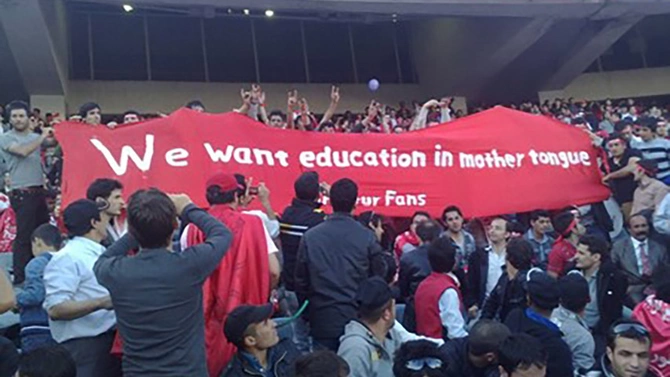
Personal favourites are slogans having to do with women’s rights. According to Brenda Shaffer’s report (p31), fans have been heard to sing:
“Oh my mother, sister and wife.
You are ladies! Men and women are equal.
Attending in community is your natural right.
Azerbaijani Turk ladies, rise and get your rights!”
It’s hard to imagine Manchester United fans getting all that polite feminism into a football song. Meanwhile, direct personal accounts suggest that many women attend the matches (officially male-only domains) by dressing as men. I wonder how they feel when hearing another off-beat chant: “Azerbaijan’s girls are the stars of the skies!”
It doesn’t stop at chanting and banners. With 677,000 followers on Instagram and 72,000 on Twitter, Tractor’s social media following has the potential to mobilize demonstrations and activism. Posts to these platforms written in Azerbaijani Turkish have been seen as an informal organization of Azerbaijani Turks, and the accounts are full of ethnonationalism. However, the authorities may have finally learned that it’s better, in the long run, to allow folks to let off steam and share their opinions.
The club’s giant Sahand Stadium sits beyond the southern fringes of Tabriz, in the mouth of a stark mountain valley. Dr. Shaffer notes wryly that the deputy chief of security in East Azerbaijan province had reportedly said of Tractor’s boisterous fans: “Let them shout all they want in the stadium outside the city and return quiet.”
[1] The piece was titled “How to Stop the Cockroaches from Making Us into Cockroaches.”
As the reader continues down the page it becomes increasing clear that “cockroach” is a euphemism for “Azerbaijani Turk”. Having discussed creative ways to destroy cockroaches, the most eye-brow raising moment comes when a Persian boy is pictured before the insect, repeating the word “cockroach” in different ways, presumably trying to teach a cockroach its own name. The cockroach, seated at a tiny desk, throws up its “hands,” and says “what?!” in Azerbaijani-Turkish.
Share on social media